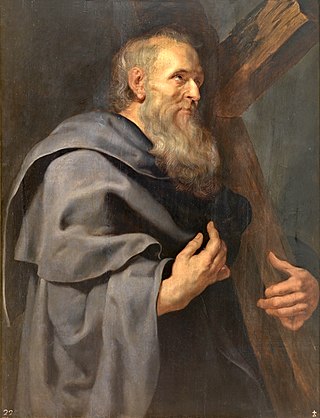
The Roman Forum, also known by its Latin name Forum Romanum, is a rectangular forum (plaza) surrounded by the ruins of several important ancient government buildings at the center of the city of Rome. Citizens of the ancient city referred to this space, originally a marketplace, as the Forum Magnum, or simply the Forum.

Philip the Apostle was one of the Twelve Apostles of Jesus according to the New Testament. Later Christian traditions describe Philip as the apostle who preached in Greece, Syria, and Phrygia.

The Papal Basilica of Saint Paul Outside the Walls, commonly known as Saint Paul's Outside the Walls, is one of Rome's four major papal basilicas, along with the basilicas of Saint John in the Lateran, Saint Peter's, and Saint Mary Major, as well as one of the Seven Pilgrim Churches of Rome.

Fulvia was an aristocratic Roman woman who lived during the Late Roman Republic. Fulvia's birth into an important political dynasty facilitated her relationships and, later on, marriages to Publius Clodius Pulcher, Gaius Scribonius Curio, and Mark Antony. All of these men would go on to lead increasingly promising political careers as populares, tribunes, and supporters of Julius Caesar.

The Basilica Aemilia was a civil basilica in the Roman Forum, in Rome, Italy. Today only the plan and some rebuilt elements can be seen. The Basilica was 100 meters (328 ft) long and about 30 meters (98 ft) wide. Along the sides were two orders of 16 arches, and it was accessed through one of three entrances.

The Basilica of Sant' Apollinare in Classe is a church in Classe, Ravenna, Italy, consecrated on 9 May 549 by the bishop Maximian and dedicated to Saint Apollinaris, the first bishop of Ravenna and Classe. An important monument of Byzantine art, in 1996 it was inscribed with seven other nearby monuments in the UNESCO World Heritage List, which described it as "an outstanding example of the early Christian basilica in its purity and simplicity of its design and use of space and in the sumptuous nature of its decoration".

The Basilica of St. Mary of the Altar of Heaven is a titular basilica in Rome, located on the highest summit of the Campidoglio. It is still the designated Church of the city council of Rome, which uses the ancient title of Senatus Populusque Romanus. The present Cardinal Priest of the Titulus Sanctae Mariae de Aracoeli is Salvatore De Giorgi.

Apamea Cibotus, Apamea ad Maeandrum, Apamea or Apameia was an ancient city in Anatolia founded in the 3rd century BC by Antiochus I Soter, who named it after his mother Apama. It was in Hellenistic Phrygia, but became part of the Roman province of Pisidia. It was near, but on lower ground than, Celaenae (Kelainai).

Hierapolis was originally a Phrygian cult centre of the Anatolian mother goddess of Cybele and later a Greek city. Its location was centred upon the remarkable and copious hot springs in classical Phrygia in southwestern Anatolia. Its extensive remains are adjacent to modern Pamukkale in Turkey.
Alia or ALIA may refer to:
A spore is an asexual biological reproductive mechanism.

Publia Fulvia Plautilla was the wife of the Roman emperor Caracalla, her paternal second cousin. After her father was condemned for treason, she was exiled and eventually killed, possibly on Caracalla's orders.

Italy has a very broad and diverse architectural style, which cannot be simply classified by period or region, due to Italy's division into various small states until 1861. This has created a highly diverse and eclectic range in architectural designs. Italy is known for its considerable architectural achievements, such as the construction of aqueducts, temples and similar structures during ancient Rome, the founding of the Renaissance architectural movement in the late-14th to 16th century, and being the homeland of Palladianism, a style of construction which inspired movements such as that of Neoclassical architecture, and influenced the designs which noblemen built their country houses all over the world, notably in the United Kingdom, Australia and the United States of America during the late-17th to early 20th centuries.
The Basilica Fulvia was a basilica built in ancient Rome. According to Livy (40.51), the censors M. Aemilius Lepidus and M. Fulvius Nobilior had it built in 179 BC. It may be that there had been a previous building existing on the site from 210 BC which was incorporated. In 78 BC, the consul M. Aemilius Lepidus incorporated the building into the Basilica Aemilia, and it was renamed the Basilica Fulvia et Aemilia or sometimes simply the Basilica.
Synaus or Synaos, also spelled Synnaus or Synnaos (Σύνναος), was a city in the Roman province of Phrygia Pacatiana, now Simav, Kütahya Province, Turkey.

In classical antiquity, Phrygia was a kingdom in the west central part of Anatolia, in what is now Asian Turkey, centered on the Sangarios River. After its conquest, it became a region of the great empires of the time.
Eumeneia or Eumenia was a town of ancient Phrygia, situated on the river Glaucus, on the road from Dorylaeum to Apameia. It is said to have received its name from Attalus II, who named the town after his brother and predecessor, Eumenes II. As of the 19th century, ruins and curious sculptures still marked the place as the site of an ancient town. On some coins found there we read Εὐμενέων Ἀχαίων, which seems to allude to the destruction of Corinth, at which troops of Attalus were present. The district of the town bore the name Eumenetica Regio, mentioned by Pliny the Elder. It inhabited during Hellenistic, Roman, and Byzantine times; for a time it also bore the name Fulvia.











